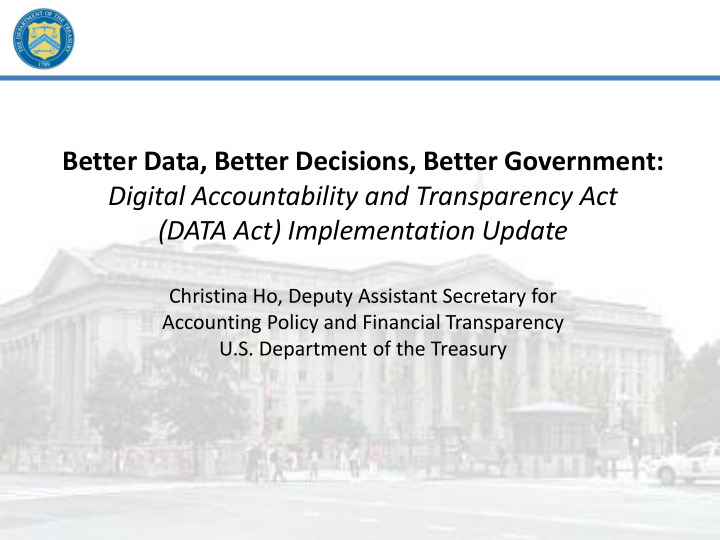



Better Data, Better Decisions, Better Government: Digital Accountability and Transparency Act (DATA Act) Implementation Update Christina Ho, Deputy Assistant Secretary for Accounting Policy and Financial Transparency U.S. Department of the Treasury
Spending Transparency • Federal Financial Accountability and Transparency Act – established USASpending.gov in 2006 • Publish data for contracts, grants, other financial assistance • USAspending.gov management moved to Treasury in 2014 2
DATA Act • Expands USAspending.gov to include agency expenditures • Requires consistent data standards • Enable the data to be used by multiple communities 3
DATA Act Requirements: Expanded data reporting on USAspending.gov for agency expenditures: – Appropriations Account • Budget authority appropriated • Obligation • Outlay • Unobligated balance • Other budgetary resources – Program Activity & Object Class • Obligation • Outlay Link the financial and award data. 4
Spending Transparency Goals • Get the data: collect data from across government in a standard format • Display the data: develop a new website that will provide the data to the public in clear, consistent manner • Use the data: provide access to the data that meets the users needs 5
Using the Data • Federal executives and program managers • Federal CFOs • State and local policy-makers and managers • Private entrepreneurs • Academics/ researchers • General public • Oversight entities 6
DATA Act Information Model Schema The Schema provides a standardized definition and conceptual model for the information relevant to the domain and public reporting of US Federal spending. The Schema informs: • How data providers select and organize information to submit • What information is stored and how it is related • How consumers can access and interpret information 7
DATA Act Information Model Schema • Reporting Submission Specification (RSS) – contains the specific guidance federal agencies need to submit content and the appropriate format for a submission • Data Elements Guidance (DEG) – contains a comprehensive listing of the elements with supporting metadata to understand context, relationships, and derivations • Schema Diagrams – visual representations of how the data elements fit together in context • Online Data Dictionary – a list of data elements with definitions and minimal metadata, like data type • XBRL Schema Files – a machine-readable format of the elements that federal agencies submit 8
DATA Act Schema Diagrams 9
Treasury’s Implementation Approach • Data-Centric Extraction: Use technology to minimize costly systems changes • Agile Technology Development: Build systems in 2-weeks sprints to reduce risk and improve outcomes • User-Centered Design: Develop the new website in the public domain with real-time collaboration with users 10
User-Centered Design • Launch an early beta site to allow the public to shape the future USAspending.gov (or a successor site) • Public can post input and ideas to contribute to the design of the site • Ongoing integration of public feedback on the development 11
OpenBeta.USAspending.gov 12
Feedback Added to Agile Development 13
Treasury DATA Act Resources • Sandbox Testing -- Each month we host sessions for agencies to test their data files using the prototype broker, and provide feedback. • Office Hours Calls -- Every Thursday, Treasury and OMB staff provide updates and take agencies' implementation questions on a conference call. • Workshops -- Ready for one-on-one help? We will come to your agency to discuss your DATA Act implementation questions and progress. • Bi-weekly Digest – Sign up to receive updates from the Treasury implementation team. 14
DATA Act Playbook • Organize Your Team • Review Elements • Inventory Data • Design & Strategize • Execute Broker • Test Broker Implementation • Update Systems • Submit Data 15
For More Information Visit: https://fedspendingtransparency.github.io/ 16
Recommend
More recommend